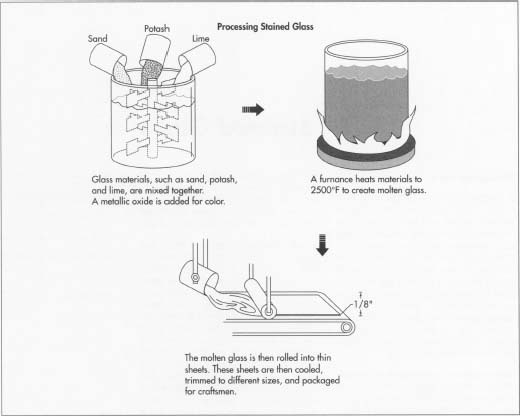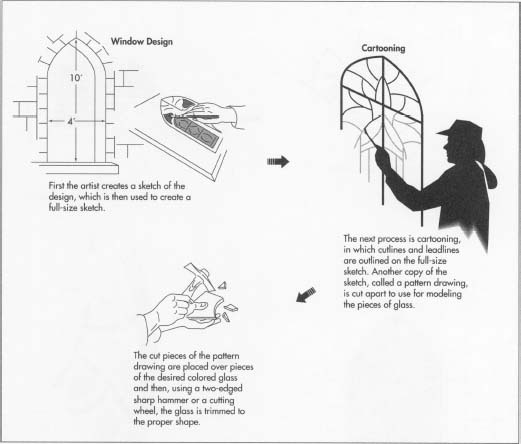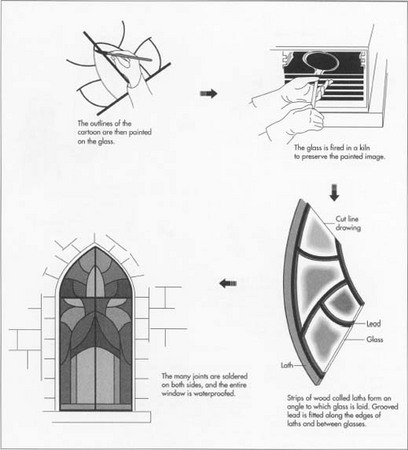Stained Glass
Background
The technology for making glass dates back at least 5,000 years, and some form of stained glass was used in European Christian churches by the third or fourth century A.D. The art of stained glass flowered in the 12th century with the rise of the Gothic cathedral. Today only 10% of all stained glasses are used in churches and other religious buildings; the rest are used in residential and industrial architecture. Though stained glass has traditionally been used in windows, its use has expanded to lamp shades, Christmas ornaments, and even simple objects a hobbyist can make.
Stained glass has had various levels of popularity throughout history. The 12th and 13th centuries in Europe have been designated as the Golden Age of Stained Glass. However, during the Renaissance period, stained glass was replaced with painted glass, and by the 18th century it was rarely, if ever, used or made according to medieval methods. During the second half of the 19th century, European artists rediscovered how to design and work glass according to medieval principles, and large quantities of stained glass windows were made.
In America, the stained glass movement began with William Jay Bolton, who made his first window for a church in New York in 1843. But he was to be in the business for only six or seven years before returning to his native England. No other American practiced the art professionally until Louis Comfort Tiffany and John La Farge began working with stained glass near the end of the 19th century. In fact, the art of stained glass in the United States languished until the 1870s, and did not undergo a true revival until the turn of the century. At this time, American architects and glassmen journeyed to Europe to study medieval glass windows, returning to create similar art forms and new designs in their own studios.
A leaded stained glass window or other object is made of pieces of glass, held together by lead. The pieces of glass are about 1/8-inch (3.2 mm) thick and bound together by strips, called "cames" of grooved lead, soldered at the joints. The entire window is secured in the opening at regular intervals by metal saddle bars tied with wire and soldered to the leads and reinforced at greater intervals by tee-bars fitted into the masonry. A faceted glass panel differs slightly from traditional leaded stained glass in that it is made up of pieces of slab (dalle) glass approximately 8 inches square, or in large rectangular sizes, varying in thickness from 1-2 inches (2.5-5 cm). These slabs are not held together with lead; rather they are embedded in a matrix of concrete, epoxy, or plastic.
Raw Materials
Glass is made by fusing together some form of silica such as sand, an alkali such as potash or soda, and lime or lead oxide. The color is produced by adding a metallic oxide to the raw materials.
Copper oxide, under different conditions, produces ruby, blue, or green colors in glass. Cobalt is usually used to produce most shades of blues. Green shades can also be obtained from the addition of chromium and iron oxide. Golden glass is sometimes colored with uranium, cadmium sulfide, or titanium, and there are fine selenium yellows as well as vermilions. Ruby colored glass is made by adding gold.

The Manufacturing
Process
Stained glass is still made the same way it was back in the Middle Ages and comes in various forms. For the glass used in leaded glass windows, a lump of the molten glass is caught up at one end of a blow pipe, blown into a cylinder, cut, flattened and cooled. Artisans also vary this basic process in order to produce different effects. For example, "flashed glass" is made by dipping a ball of molten white glass into molten colored glass which, when blown and flattened, results in a less intense color because it will be white on one side and colored on the other.
So-called "Norman slabs" are made by blowing the molten glass into a mold in the shape of a four-sided bottle. The sides are cut apart and form slabs, thin at the edges and as much as 0.25 inch (0.6 cm) thik) at the center. Another form of glass, known as cathedral glass, is rolled into flat sheets. This results in a somewhat monotonous regularity of texture and thickness. Other similarly made glasses are referred to as marine antique, but have a more bubbly texture.
Processing the stained glass
-
1 Large manufacturers of stained glass mix the batch of raw materials,
including alkaline fluxes and stabilizing agents, in huge mixers. The
mix is then melted in a modern furnace at 2500°F (1371°C).
Each ingredient must be carefully measured and weighed according to a
calculated formula, in order to produce the appropriate color. For
cathedral glass, the molten glass is ladled into a machine that rolls
the glass into 1/8-inch (3.2
mm) thick sheets. The sheets are then cooled in a special furnace called an annealing lehr. The glass is then inspected, trimmed to standard size, and packed into cases.

At a typical factory, eight to ten different color runs are made per day. Some manufacturers cut a small rectangle of glass from each run in order to provide a sample of each color to their customers. There are hundreds of colors, tints, and patterns available, as well as a number of different textures of cathedral glass. Different textures are produced by changing the roller to one having the desired texture. Glass manufacturers are continuously introducing new colors and types of glass to meet the demands of their customers.
Creating the window pattern
-
2 Though some of the tools to make stained glass windows have been
improved, the windows are still hand crafted as they were centuries ago.
The first step of the process involves the artist creating a small scale
version of the final design. After the design has been approved, the
craftsperson takes measurements or templates of the actual window
openings to create a pattern. This pattern is usually drawn on
paper
or cardboard and is the actual size of the spaces to be filled with
glass.
Next a full-sized drawing called the cartoon is prepared in black and white. From the cartoon, the cutline and pattern drawings are
made. The modern cutline drawing is a careful, exact tracing of the leadlines of the cartoon on heavy paper. The leadlines are the outlines of the shapes for patterns to which the glass is to be cut. This drawing serves as the guide for the subsequent placing and binding with lead of the many pieces of glass.
The pattern-drawing is a carbon copy of the cutline drawing. It is cut along the black or lead lines with double-bladed scissors or a knife which, as it passes through the middle of the black lines, simultaneously cuts away a narrow strip of paper, thus allowing sufficient space between the segment of glass for the core of the grooved lead. This core is the supporting wall between the upper and lower flanges of the lead.
Cutting and painting
- 3 Colored glass is then selected from the supply on hand. The pattern is placed on a piece of the desired color, and with a diamond or steel wheel, the glass is cut to the shape of the pattern. After the glass has been cut, the main outlines of the cartoon are painted on each piece of glass with special paint, called "vitrifiable" paint. This becomes glassy when heated. The painter might apply further paint to the glass in order to control the light and bring all the colors into closer harmony. During this painting process, the glass is held up to the light to simulate the same conditions in which the window will be seen. The painted pieces are fired in the kiln at least once to fuse the paint and glass.
Glazing and leading
- 4 The next step is glazing. The cutline drawing is spread out on a table and narrow strips of wood called laths are nailed down along two edges of the drawing to form a right angle. Long strips of grooved lead are placed along the inside of the laths. The piece of glass belonging in the angle is fitted into the grooves. A strip of narrow lead is fitted around the exposed edge or edges and the next required segment slipped into the groove on the other side of the narrow lead. This is continued until each piece has been inserted into the leads in its proper place according to the outline drawing beneath.
Finishing
- 5 The many joints formed by the leading are then soldered on both sides and the entire window is waterproofed. After the completed window has been thoroughly inspected in the light, the sections are packed and shipped to their destination where they are installed and secured with reinforcing bars.
Faceted glass
-
6 For faceted glass windows, the process begins the same way, with the
cutline and pattern drawings being made with carbons in a similar
manner. The pattern drawing is then cut to the actual size of the piece
of glass with ordinary scissors since there is no core of lead to allow
for. The thick glass slabs next are cut with a sharp double-edged hammer
to the shape of the pattern. To give the slab an interesting texture,
the worker then chips round depressions in the glass with the same
hammer. This is called faceting.
Instead of glazing with lead, a matrix of concrete or epoxy is poured around the pieces of glass. The glass pieces have first been glued to the outline drawing, which is covered with a heavy coating of transparent grease so that the paper can be removed after the epoxy sets. The whole is enclosed within a wooden form, which is the exact size and shape of the section being made. The worker must wear gloves during this process, since epoxy resin is a toxic material. After hardening, the section is cleaned and cured prior to shipping and installation.
The process for making an entire stained glass window can take anywhere from seven to ten weeks, since everything must be done by hand. Cost can vary widely depending on complexity and size, though some windows can be created for a cost as low as $500. The customer can choose an existing pattern rather than create an entirely new one to minimize costs. In this case, the pattern can be customized by altering shapes or by changing the placement of the central image.
The Future
In the last 20 years there has been an explosion in growth of glass studios in the United States and it appears this growth will continue. For instance, in Ohio alone the number of studios has increased from a mere half a dozen to at least 100. The Stained Glass Association of America membership includes 500 studio owners and 300 manufacturers. The circulation of its quarterly publication totals 6,000. There has been a resurgence in restoration overseas, and the home market continues to grow. The hobby market also appears strong, with one publication serving this market having a circulation of 15,000. It is clear that stained glass is now recognized as a true art form no matter where it is used, and innovative designs using this medium will continue to flourish.
Where To Learn More
Books
Clark, Willene B. The Stained Glass Art of William Jay Bolton. Syracuse University Press, 1992.
Clarke, Brian, ed. Architectural Stained Glass. McGraw-Hill, 1979.
Plowright, Terrance. Stained Glass Inspirations and Designs. Kangaroo Press, Australia, distributed by Seven Hills Book Distributors, 1993.
Other
Achilees, Rolf and Neal A. Vogel. Stained Glass in Houses of Worship. Inspired Partnerships Inc. and the National Trust for Historic Preservation, 1785 Massachusetts Avenue NW, Washington, DC 20036.
The Story of Stained Glass, 1984. The Stained Glass Association of America, PO Box 22642, Kansas City, MO 64113. 800-888-7422,816-333-6690.
— Laurel M. Sheppard